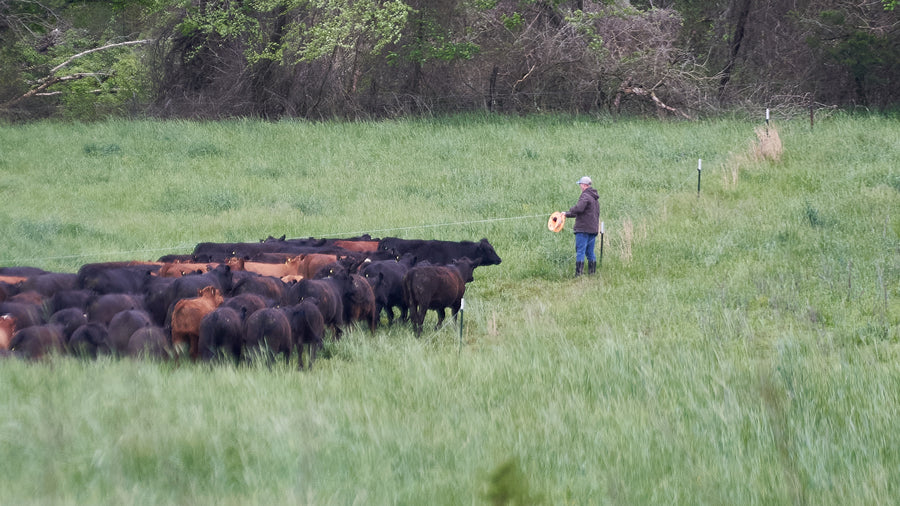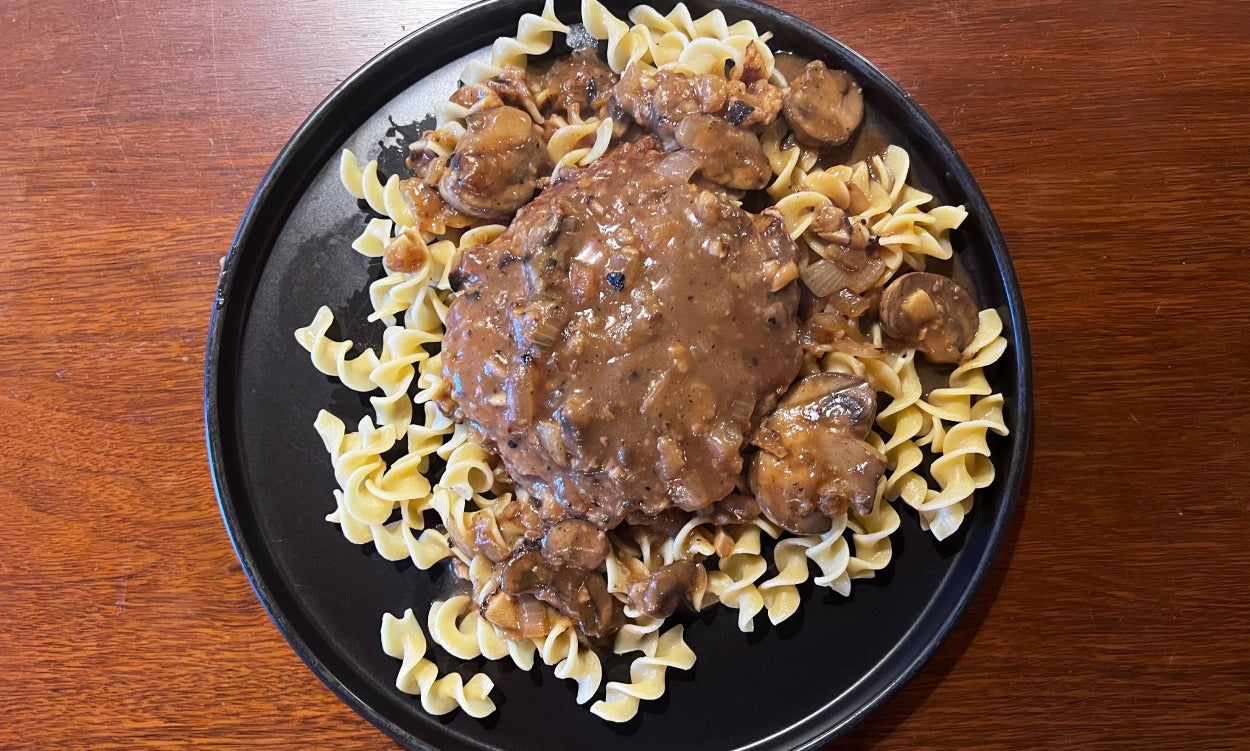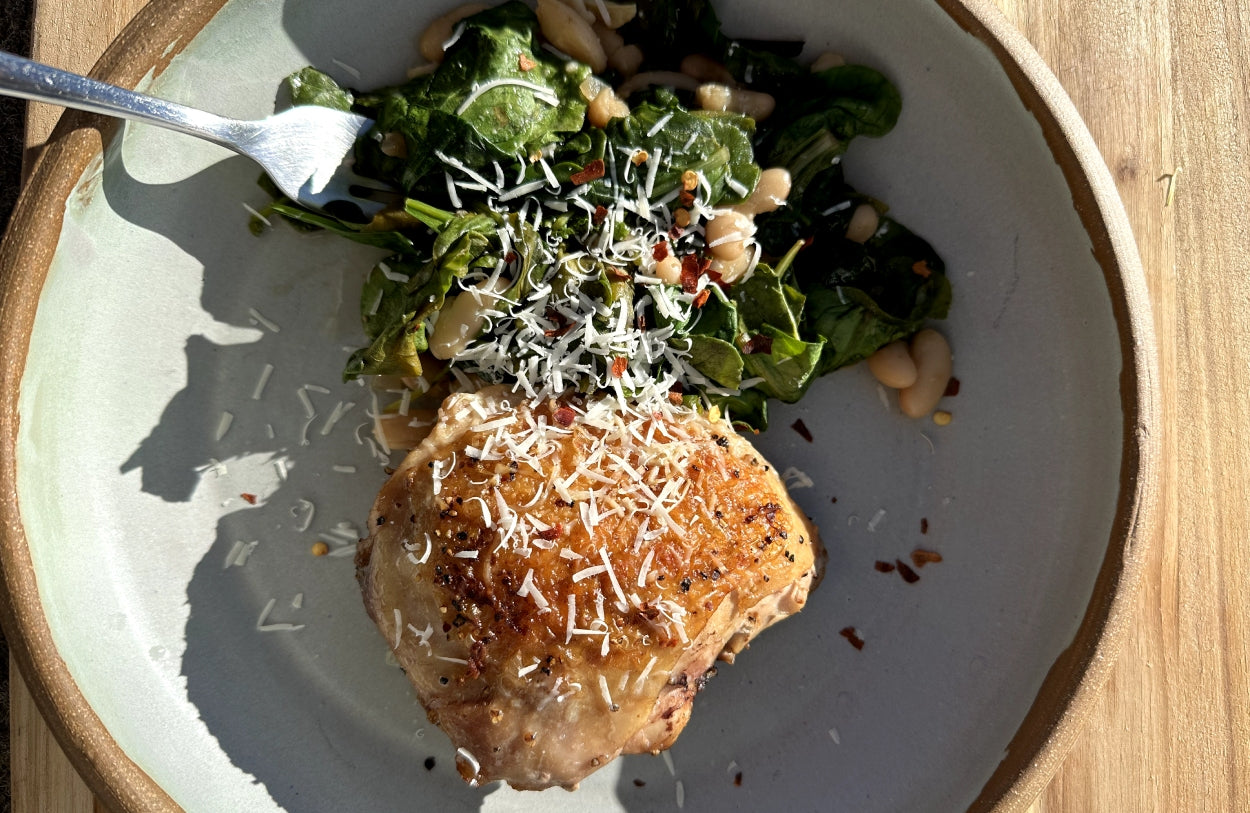What Is Regeneratively-Raised Beef? 6 Characteristics

As more consumers are asking questions about exactly where their food is coming from, their research often leads to one common question: “What is regeneratively raised beef?”
The phrase sounds inherently positive, but what exactly does this term mean and how is it different from the grocery store meat that’s labeled “grass fed” or “pastured”?
To understand what regeneratively-raised beef is, and the implications for choosing it for your family’s table, we’re going to cover the following important topics:
- What is regenerative agriculture?
- Why does rotational grazing matter so much?
- What is the difference between grass fed and grass finished beef?
- Are there nutritional benefits to eating regeneratively-raised beef?
- What is the cost difference between regenerative vs conventional meat?
- How and where can you find regenerative beef?
- Plus, 3 of our favorite regenerative beef recipes!

What is regenerative agriculture?
In the 1980s, the Rodale Institute coined the term “regenerative agriculture”, but the ethos and practices of this movement have been the norm in many Native and Indigenous communities for centuries.
At its core, regenerative agriculture revolves around the belief that agriculture can only be truly sustainable when we work with the land, instead of viewing nature as a limitless resource we can constantly take advantage of.
Regenerative farmers have turned away from industrial agricultural methods and instead have opted for practices that:
- Rebuild and grow new, healthy topsoil
- Encourage soil and plant biodiversity
- Reject chemical inputs and their associated pollution
- Reduce runoff, which protects natural waterways
- Rebalances ecosystems and protects beneficial insects, including pollinators like bees
Some of the more common regenerative agriculture methods include cover crops, crop rotation, and no-till planting methods.
In addition, regenerative farmers go to great lengths to minimize animal discomfort by providing conditions that allow them to express their instinctive animal behavior. This is part of why every regenerative farm is free range, instead of restricting animals to feedlots and pens.
Regenerative agriculture also provides downstream welfare benefits for farm workers because the lack of harsh chemicals and risk factors associated with animals in confinement creates more safe working conditions.

Soil health is the beating heart of regenerative agriculture.
Think of soil as the foundation of our food system. Healthy soil produces high quality, nutrient dense food for animals and humans alike.
On a regenerative farm, animals are allowed to graze freely, as they would if they were in the wild. Livestock will instinctively forage across the pasture for the most nutritious options available, which means that no one section of grass is ever eaten all the way down to bare ground. This allows plant root systems to stay intact, and the stimulation of grazing chickens and the hooves of cows and sheep further improves soil quality, along with the manure they leave behind.
Healthy soil also provides another significant environmental benefit that is still, unfortunately, not widely known.
Regeneratively raised beef is fighting global warming.
Studies have shown that regeneratively raised beef contributes to reduced carbon emissions. By fostering healthy grasslands and soil that’s alive with roots and microbes continually drawing carbon out of the atmosphere, regenerative beef creates a carbon drawdown greater than the amount of methane being produced by the cattle themselves.

Why does rotational grazing matter so much?
Rotational grazing is the central practice of regenerative agriculture. As its name suggests, it is the practice of allowing livestock to move to fresh pasture regularly - in most cases, daily.
This mimics how an animal would behave if they were freely grazing in the wild, which therefore provides a more humane experience for the animals, while also allowing the land time to recover and regrow after animals have grazed on it.
The primary benefits of rotational grazing are:
- Pasture health. Pastures have time to rebound and regrow, while manure breaks down and naturally fertilizes the land, returning nutrients to grass, legumes, and weeds.
- Animal health. Regular access to fresh non-GMO pasture gives animals rich and varied nutritional sources. Unlike conventionally-raised beef that is sedentary for most of its life, regeneratively-raised beef is able to freely forage and experiences naturally cleaner living conditions, as a result.
- Human health. This is the simplest one. Healthier animals produce healthier meat.
- Environmental health. Cattle eat plants that have absorbed carbon dioxide from the air. But thanks to rotational grazing, the cattle then move on to fresh pasture, ensuring that no one section is over-grazed. Letting the land rest in between grazing cycles allows the foliage to grow more leaves, which in turn capture more carbon. And on it goes.
What is the difference between grass fed and grass finished beef?
Animals raised on a regenerative farm are 100% grass fed and grass finished. These two terms are sometimes treated as interchangeable, but they refer to two very different scenarios. It’s important to understand this difference, so that you can make the most informed decisions when purchasing meat for your family.
Grass-fed and finished beef comes from cattle that ate absolutely nothing but grass and foliage for their entire lives. No grain or grain by-products at all.
However, a package of beef can be labeled as “grass fed” if the cattle started their lives eating a grass diet but then subsequently received a supplemental grain mix or ate a 100% grain-based diet in the final months before they were harvested. The latter is a very common practice on many feedlots that attempt to help cattle quickly gain weight before they’re sold.
Meat can be labeled “grass fed” even if the cattle did not eat a 100% grass-fed diet.
In addition, so-called “grass-fed” cows are not necessarily pasture-raised, so they may have been fed grass at one point, but could have spent most of their lives confined to pens or small pastures not suited to their natural grazing tendencies.
To get the nutrients from pasture-raised cattle that were allowed to grow at their natural pace, and were never subjected to the digestive problems of feeding grain to a ruminant, we highly recommend that you always opt for grass-finished and pasture-raised regenerative beef.
These are the characteristics that confirm you’re making the most ethical, nutritious, flavorful, and eco-friendly choice in the meat you’re purchasing.
Are there nutritional benefits to eating regeneratively-raised beef?
Here at Grass Roots Farmers Co-op, our regeneratively-raised beef is 100% grass-fed and finished. Our cattle are free to graze on non-GMO pasture, outside in the sunshine as nature intended, every single day. They never eat grain or grain by-products, and are never treated with antibiotics or hormones.
Multiple studies have confirmed that cattle raised under these conditions are more flavorful than conventionally-raised beef. In addition, studies have also shown that regenerative beef also provides several nutritional benefits, such as:
- Glutathione, also known as the “Master Antioxidant”
- Significant source of L-Carnitine
- High in protein and several minerals
- Carnosine, CLAs and Creatine
- Rich in B vitamins
What is the cost difference between regenerative vs conventional meat?
Yes, regeneratively-raised beef costs more than conventional meat. Why is that?
Regenerative agriculture is more labor intensive. This is the primary reason for its higher costs - human hands are doing the jobs that are typically assigned to chemicals or machinery on conventional farms. Industrial agriculture operations achieve their profits by emphasizing quantity over quality, but this brings substantial environmental and nutritional costs.
We invest in what we value. And we value responsible land stewardship and the most nutritionally-rich meat possible, produced with far-reaching ethical considerations.
How and where can you find regenerative beef?
Maybe the only discouraging aspect of regenerative beef is that currently, it is not highly accessible. It’s certainly becoming more mainstream, but is still not widely available in many grocery stores, so you will have to seek it out from a validated source.
Grass Roots animals are regeneratively-raised, and our partnership with Heifer USA aims to verify that we are indeed tracking regeneratively across all farms. Many Grass Roots products have also been given the Savory Institute’s Land to Market certification, which confirms that meat was sourced from verified regenerating land.
The bottom line about regenerative beef:
Contrary to popular opinion, it is very possible to be an environmentally-conscientious meat eater. Regenerative agriculture is the answer.
Responsible land use and animal management leads to the production of meat that is not only tastier and more nutritious, but also contributes to reducing the effects of climate change.
To ensure that you’re purchasing the most trustworthy regeneratively-raised beef, we recommend looking for a farmer that explicitly states that their cattle is grass finished and pasture raised.
Try our favorite regenerative beef recipes!
Guinness Beef Stew with Mashed Potatoes
What you need to know about the regeneratively-raised beef from Grass Roots Farmers Co-Op:
Every Grass Roots animal is born, raised and harvested in the USA. They graze on natural, non-GMO pasture and are never treated with hormones or antibiotics. Our cattle are grass-fed and grass finished, and never eat grain or grain by-products.
Every member of our small co-op of farms practices regenerative farming methods that foster a diversity of plants, use no-till methods, and incorporate grazing animals to restore the soil biodiversity. Our farms and processing facilities maintain the highest standards and provide economic opportunities in rural communities.
Order your Grass Roots regeneratively raised beef here.
Recent Posts






